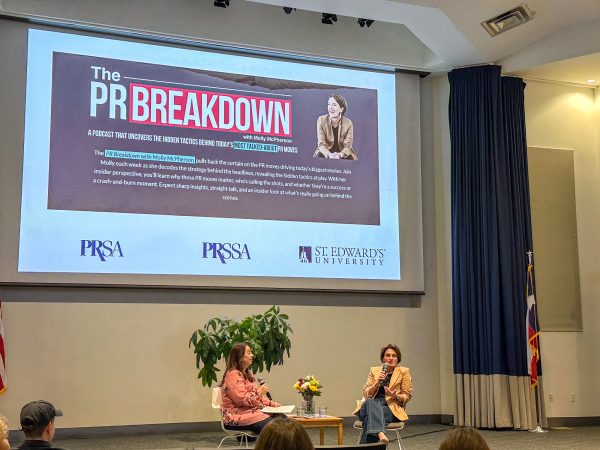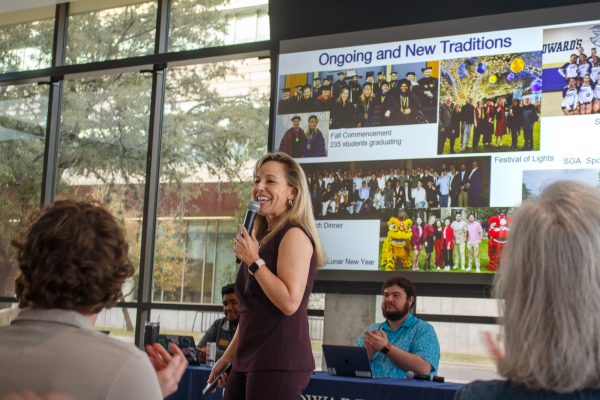9VOTING
Yesterday was Election Day.
For anyone who exercised their democratic right to vote, here’s where the St. Edward’s University voting community stood on Election Day.
Early voting in Texas ended Nov. 4, and students and faculty flocked to Ragsdale lobby Nov. 1 to cast their ballots. A total of 631 members of the St. Edward’s community voted on campus, according to the Travis County Clerk.
Yet for many students, getting to the polls was the easiest part. Choosing a candidate was the hard part.
Sophomore Marcos Ramirez kept up with politics and watched every debate, but still remains doubtful of the FBI re-opening the investigation over Hillary Clinton’s emails 11 days before the election. That said, the sophomore says nothing could change his mind at this point, claiming, “It’s too late.”
But Ramirez isn’t the only one. Within the final days left of the election, the FBI notified Congress of ongoing investigations on both Donald Trump and Clinton. Clinton’s email scandal was under investigation while Trump’s ties to Russia are under strict scrutiny.
The FBI investigation on Trump questioned alleged connections between his those who backed his presidential campaign and Russia. The U.S. government has publicly accused the Russian government of interfering with the election by hacking the Democratic party, attempting to hack voter registration databases and releasing sensitive documents, such as Clinton’s emails.
Clinton’s emails have been questioned repeatedly due to the bureau’s investigation of her private email server use while serving as secretary of state. More emails were revealed in a separate investigation into Anthony Weiner, the estranged husband of Clinton aide Huma Abedin and former congressman. Weiner had been implicated in a sexting scandal with multiple women.
The FBI’s inability to verify the implications of either investigation has resulted in backlash ranging from statements President Barack Obama made while campaigning for Clinton to an open letter to FBI director James Comey from the 15-year-old girl involved in the Weiner scandal.
And recently, the FBI ended its investigation on Clinton – again, according to a letter sent to Congress on Sunday from Comey.
The convoluted and poorly communicated information on these issues has influenced the decisions of many voters, including students on campus.
Former Bernie Sanders supporter and sophomore Sea D’Amico has learned a bit in the classroom that influenced her decision to vote for Clinton.
“I’m a global studies major, so we learn a lot about democracy, sustaining it and how it works in different places and [how to] define that to our current state of politics,” D’Amico said. “A lot of my professors here are trying to keep us informed or trying to encourage us to be involved.”
Voter engagement has proven difficult for college students and millennials. An estimated 69.2 million adults are of voting age, according to the Pew Research Center. Based on the Census Bureau’s estimates of voter turnout, young adults such as millennials are less likely to vote than their older counterparts.
For second time voters like senior Stephanie Espinoza, this election is different.
“I’ve been so [much] more involved than I’ve been in past elections,” Espinoza said. “I feel like a lot of people have stepped up because what it came down to.”
Although he can’t vote because he’s not an American citizen, sophomore and Peruvian citizen Chris Azaldegui shares similar sentiments.
“We’re in a bad situation right now,” Azaldegui said. “It’s like a lose-lose, but it’s like there’s different levels to losing.”
This election has been one of the most polarized elections among Democrats and Republicans alike. Azaldegui, like many Americans, feels the significance of casting a ballot this year whether Republican, Democrat or other.
“It depends who you are too,” Azaldegui said. “I can see how the majority of the population could be bitterly affected if [Trump] was elected, but I feel like [Clinton] is the better option.”
A wider ideological gap between more and less educated adults exists along educational and generational lines with highly educated adults far more likely than those with less education to take liberal positions on political issues, according to the Pew Research Center.
“Our two-party system is showing itself to be very scary. And this is like a tiny part that we’re seeing that isn’t working… Now it’s really not working because it’s so polarized,” D’Amico said.
Frustration with this election hasn’t been limited to the candidates and their platforms, but also voters who faced other struggles that prevented them from getting to the polls.
Former Sanders supporter D’Amico expressed that she would vote for Clinton but has a barrage of voter identification issues to sort out, such as having a New York driver’s license and trying to navigate voting in Texas.
“I tried to vote here, and they’re like, ’Your [driver’s license] isn’t good enough,’” D’Amico said. “I did have my voter registration card, but they still wouldn’t let me vote.”
Some voters are still facing instances where they are asked to show identification, despite such requests being against the law. These former identification requirements violated the Voting Rights Act of 1965, which prohibited racial discrimination in voting.
Within days of the general election, many Americans remained unaware of their state’s voter identification requirements.
About four in 10 voters living in states with no identification requirement incorrectly believed that they would be required to show identification before voting, while in states that do require identification, one-in-five voters didn’t know photo identification was needed, according to the Pew Research Center.
“They handed me a sheet and they were like, ‘You need one of these seven forms of ID,’” D’Amico said. “And I was like, ‘Oh, I don’t have them.’”






